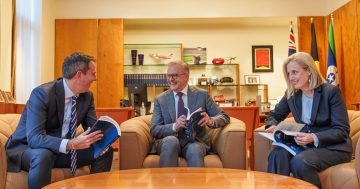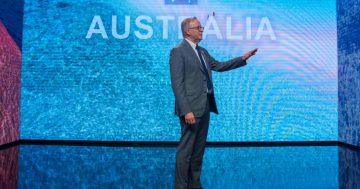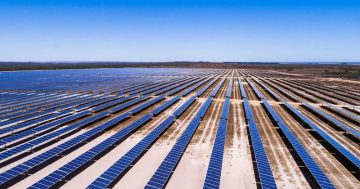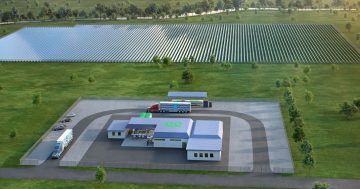
Prime Minister Anthony Albanese (centre) at QUT’s Advanced Battery Facility in Brisbane for the National Battery Strategy launch. Photo: QUT.
More detail has been provided on one of the key tenets of the Federal Government’s Future Made in Australia policy announced in last week’s Budget, with the release of its $500 million National Battery Strategy to manufacture storage batteries in Australia.
The strategy was launched on Wednesday afternoon by Prime Minister Anthony Albanese and Minister for Industry and Science Ed Husic at the QUT Advanced Battery Facility in Brisbane.
The government says the global demand for batteries will quadruple by 2030 as economies aim for net-zero carbon emissions. It says the National Battery Strategy maps a path for Australia to take advantage of this growth to build its own battery industry.
The plan identifies four strategic opportunities:
- Stationary storage – building energy storage systems to firm renewable power generation in the national grid and for communities, businesses and homes.
- Provide battery active materials by upgrading raw minerals into processed battery components for battery supply chains.
- Leveraging Australia’s know-how to build safer and more secure batteries connected to the grid.
- Building batteries for the transport manufacturing industry, including heavy-vehicle manufacturing.
Minister Husic said Australia was a pioneer of battery technology, but had been sending its ideas offshore and had lost the good jobs it created.
“A strong battery industry can supercharge our path to net zero and create a Future Made in Australia,” he said. “Australia is moving beyond a ‘dig and ship’ economy to become a renewable-energy superpower.
“It’s inexcusable that we supply half the global supply of lithium but produce less than 1 per cent of the world’s processed battery components.
“The global clean-energy transition is happening – and we’ve got a once-in-a-lifetime opportunity for Australia to create more well-paid, secure jobs.”
The funding for the battery strategy as revealed in the Budget includes $523.2 million for the battery breakthrough initiative to promote the development of battery manufacturing capabilities via production incentives, and $20.3 million for building future battery capabilities to incentivise battery research and support for the Future Battery Industries Cooperative Research Centre, and the Powering Australia Industry Growth Centre.
The Future Made in Australia funding also includes $1.7 billion for an Innovation Fund to be administered by the Australian Renewable Energy Agency (ARENA) to accelerate the rollout of innovative technologies and facilities through support for innovation, commercialisation, and pilot and demonstration projects in priority sectors including clean-energy manufacturing such as batteries.
The Prime Minister said he wanted to make more things in Australia and, with global demand for batteries set to quadruple by 2030, Australia must be a player in this field.
“Batteries are a critical ingredient in Australia’s clean-energy mix,” he said.
“Together with renewable energy, green hydrogen and critical minerals, we will meet Australia’s emission-reduction targets and create a strong clean-energy manufacturing industry.”
Director of the QUT Energy Storage Research Group, Associate Professor Joshua Watts, said Australia had natural advantages across the whole battery value chain in battery materials.
“Australia is at the precipice of an incredible economic opportunity to supply the world with the commodities and products that are needed to meet the global clean-energy transition while simultaneously fortifying our nation’s energy security,” he said.
“We have all the critical minerals that are needed to make a diverse range of battery technologies which, combined with an abundant supply of renewable-energy resources, can power and grow a sustainable battery manufacturing sector in Australia.
“QUT’s Advanced Battery Facility, in collaboration with other universities nationally, is ready to support local industry to innovate and take full advantage of the massive opportunity that lies ahead of us.”
In a 23 May post on Twitter/X, independent Senator for the ACT David Pocock welcomed the initiative.
“Australia is the source of 50 per cent of battery minerals globally, but 75 per cent of supply comes from China,” he said. “We are well placed to develop a value-adding industry and reduce sovereign risk.”











